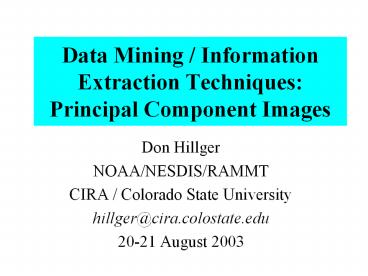Data Mining Information Extraction Techniques: Principal Component Images PowerPoint PPT Presentation
Title: Data Mining Information Extraction Techniques: Principal Component Images
1
Data Mining / Information Extraction
TechniquesPrincipal Component Images
- Don Hillger
- NOAA/NESDIS/RAMMT
- CIRA / Colorado State University
- hillger_at_cira.colostate.edu
- 20-21 August 2003
2
Principal Component Image (PCI) transformation
of multi-spectral imagery
- Terminology/Definitions
- PCI Principal Component Image a new image
combination - Eigenvectors transformation vectors to create
PCIs from multi-spectral imagery - Eigenvalues explained variances (weights) of
the principal component images
3
Why transform imagery?
- To simplify multi-spectral imagery by reducing
redundancy to obtain the independent information - A new set of images that are optimal
combinations of the original spectral-band images
for extracting the variance in the available
imagery - Important image combinations for detection of
atmospheric and surface features in
multi-spectral data
4
GOES Imager bands
5
General Case
- band(N) ? PCI(N)
- The number of component images resulting from a
PCI transformation is equal to the number of
spectral-band images input. - The sum of the explained variances of the
component images is equal to the sum of the
explained variances of the original images (the
same information content as the original imagery
expressed in a new form)
6
General Case
- PCI E _at_ B
- where
- PCI transformed set of N images, at M
horizontal locations (pixels) - E N by N transformation matrix. The rows of E
are the eigenvectors of the symmetric matrix with
elements determined by the covariance of each
band with every other band (summed over M pixels) - B set of imagery from N bands, viewing a scene
at M horizontal locations (pixels)
7
Two-dimensional Case
- pci1 e1 _at_ band1 e2 _at_ band2
- pci2 f1 _at_ band1 f2 _at_ band2
- where
- pci1 and pci2 Principal Component Images
(PCIs) - band1 and band2 band images
- e and f linear transformation vectors
(eigenvectors, or rows in the eigenvector matrix
E). - In the two-dimensional case
- pci1 usually contains the information that is
common to the band1 and band2 images - pci2 contains the information that is different
between the band1 and band2 images.
8
2-dimensional case Montserrat / Soufriere Hills
volcano
2 PCIs
2 bands
9
2-dimensional case Montserrat / Soufriere Hills
volcano
Comparison to ash-cloud analysis
10
GOES 5-band Imager Covariance Matrix
11
GOES 5-bandPrincipal Component Matrix
12
5-band transform (GOES Imager)
13
5-band transform (GOES Imager)
14
5-band transform(GOES Imager)
5 bands
5 PCIs
15
5 bands (GOES Imager)
16
5 PCIs (GOES Imager)
17
Signal-to-Noise(GOES Imager)
? 5 bands
5 PCIs ?
18
19-band transform(GOES Sounder)
19 bands
19 PCIs
19
19-band transform (GOES Sounder)
20
19-band transform (GOES Sounder)
21
19 bands (GOES Sounder)
22
19 PCIs (GOES Sounder)
23
Signal-to-Noise(GOES Sounder)
? 19 bands
19 PCIs ?
24
Analysis of MODIS
25
Analysis of MODIS
26
Northeast UT fog/status 7 Dec 2002 18 UTC
27
Northeast UT fog/status 12 Dec 2002 18 UTC
28
Principal Component Images of fire hot spots and
smoke
clouds
clouds
smoke
smoke
rings of fire
Arizona fires 21 June 2002 1806 UTC (MODIS)
29
Principal Component Images of fire hot spots and
smoke
smoke
rings of fire
smoke
Arizona fires 23 June 2002 1754 UTC (MODIS)
30
In conclusionWhy transform imagery?
- To simplify multi-spectral imagery by reducing
redundancy to obtain the independent information - A new set of images that are optimal
combinations of the original spectral-band images
for extracting the variance in the available
imagery - Important image combinations for detection of
atmospheric and surface features in
multi-spectral data

